
An infantry fighting vehicle (IFV), also known as a mechanized infantry combat vehicle (MICV), is a type of armoured fighting vehicle used to carry infantry into battle and provide direct-fire support. The 1990 Treaty on Conventional Armed Forces in Europe defines an infantry fighting vehicle as "an armoured combat vehicle which is designed and equipped primarily to transport a combat infantry squad, and which is armed with an integral or organic cannon of at least 20 millimeters calibre and sometimes an antitank missile launcher". IFVs often serve both as the principal weapons system and as the mode of transport for a mechanized infantry unit.

Self-propelled artillery is artillery equipped with its own propulsion system to move toward its firing position. Within the terminology are the self-propelled gun, self-propelled howitzer, self-propelled mortar, and self-propelled rocket artillery. They are high-mobility vehicles, usually based on continuous tracks carrying either a large field gun, howitzer, mortar, or some form of rocket/missile launcher. They are usually used for long-range indirect bombardment support on the battlefield.

The M113 is a fully tracked armored personnel carrier (APC) that was developed and produced by the FMC Corporation. The M113 was sent to United States Army Europe in 1961 to replace the mechanized infantry's M59 APCs. The M113 was first used in combat in April 1962 after the United States provided the South Vietnamese army (ARVN) with heavy weaponry such as the M113, under the Military Assistance Command, Vietnam (MACV) program. Eventually, the M113 was the most widely used armored vehicle of the U.S. Army in the Vietnam War and was used to break through heavy thickets in the midst of the jungle to attack and overrun enemy positions. It was largely known as an "APC" or an "ACAV" by the allied forces.
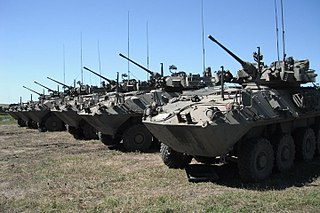
The LAV II Bison and Coyote are armoured cars, or armoured personnel carriers built by General Dynamics Land Systems Canada for the Canadian Armed Forces. Bison vehicles have been used to a lesser extent by the Australian Army and the US National Guard.

The FV432 is the armoured personnel carrier variant in the British Army's FV430 series of armoured fighting vehicles. Since its introduction in the 1960s, it has been the most common variant, being used for transporting infantry on the battlefield. At its peak in the 1980s, almost 2,500 vehicles were in use.

The K200 KIFV is a South Korean armored personnel carrier, originally produced by Daewoo Heavy Industries as a domestic replacement for older armored personnel carriers, such as the M113, in front line service with the Republic of Korea Armed Forces at the time of the K200's development. Since 2009 the K200 has been supplemented by the K21. A total of 2,383 K200 vehicles of all configurations were produced between 1985 and 2006, among which are 111 K200A1 vehicles exported to Malaysia.

The AIFV is a US tracked light armored vehicle that serves as an infantry fighting vehicle (IFV) in the armies of several countries. It is a development of the M113A1 armored personnel carrier.
A huge number of M113 armored personnel carrier variants have been created, ranging from infantry carriers to nuclear missile carriers. The M113 armored personnel carrier has become one of the most prolific armored vehicles of the second half of the 20th century, and continues to serve with armies around the world in many roles.

The Type 63 is a Chinese armoured personnel carrier that entered service in the late 1960s. It was the first armoured vehicle designed in China without Soviet assistance. The design is simple and is comparable to other APCs of its time such as the M113.

The Dragoon 300 AFV was produced by Arrowpointe Corporation during the 1980s. It was based on the automotive components of the United States Army's M113 APCs and 5-ton trucks. It resembles a larger V-150 Commando.

The KTO Rosomak is an 8×8 multi-role military vehicle produced by Rosomak S.A., a Polish Armaments Group company, in Siemianowice Śląskie. The vehicle is a licensed variant of the Finnish Patria AMV.

The BTR-3 is an eight-wheel drive armored personnel carrier developed in 2000 and 2001 by an international consortium. The companies involved in the project include the Kharkiv Morozov Machine Building Design Bureau of Ukraine, Adcom Systems of Abu-Dhabi, UAE, and the State Scientific Technical Centre of Artillery & Rifle Arms of Ukraine. Although somewhat similar in appearance to the Soviet BTR-80, the BTR-3U is an all-new production vehicle rather than an update of the existing in-service vehicle.
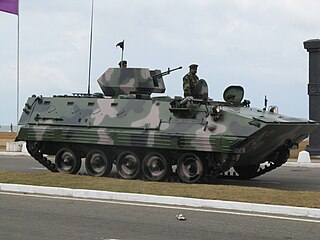
The Norinco Type 89 tracked armoured fighting vehicle is a Chinese armoured personnel carrier. It was developed from the earlier export market Type 85 AFV vehicle. It entered service in the late 1990s and was first shown publicly in 1999. There are approximately 1,000 in service. It has the industrial index of WZ534 and although it was mainly developed for the PLA, there is also an export version YW534.

The Type 85 is a tracked armoured fighting vehicle produced by Chinese company Norinco. It is an improved version of the Type 63 armoured personnel carrier. The vehicle is bigger, has additional firing ports and periscopes, a longer chassis with an additional road wheel on each side, and is equipped with an NBC protection system.

The Type 90 is an armoured fighting vehicle produced by Chinese company Norinco; it is the successor for the Type 85 AFV of which it uses some components. The Type 90 series was developed for export, and consists of at least 10 different types; its industrial index is YW535.

The Fahd is a 4x4 Egyptian armored personnel carrier, designed to fit the requirements of the Egyptian Military. It replaced older APCs in Egyptian service such as the BTR-40, and the Walid. It has been used by the United Nations.
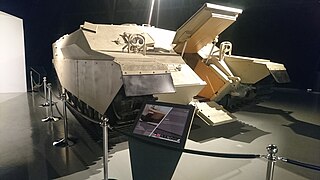
Dawsar or MAP II is a heavily armored personnel carrier developed by King Abdullah Design and Development Bureau. It is based on Tariq main battle tank, an upgraded version of Centurion. The Jordanian Army received four of these vehicles in 2014.

The ZBD-03 or Type 03 is a Chinese airborne infantry fighting vehicle. It features a light-weight chassis and hydropneumatic suspension for airborne operations. Early prototypes received the designation ZLC-2000.
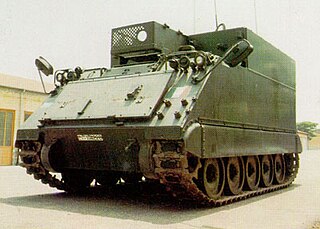
The M577 command post carrier, also known as the M577 command post vehicle or armored command post vehicle, is a variant of the M113 armored personnel carrier that was developed and produced by the FMC Corporation to function on the battlefield as a mobile command post i.e. a tactical operations centre, usually at the battalion level. In U.S. military service its official designation is Carrier, Command Post, Light Tracked M577.
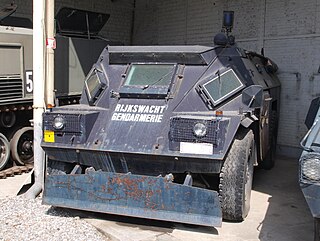
The Timoney armoured personnel carrier refers to a series of armored personnel carriers developed by Timoney Technology Limited of Ireland in the 1970s and 1980s.





































